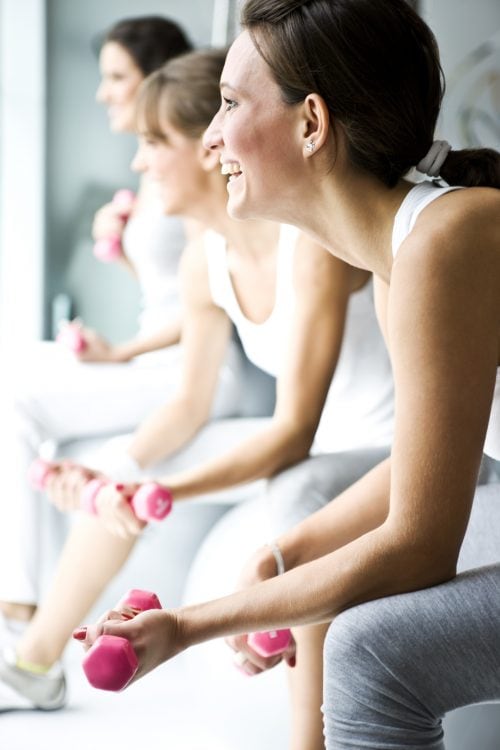
We share expert tips to help you achieve your diet and exercise goals and stay active.
Getting started
1. Commit yourself: Buy new gear, join a gym, or rope in a friend to be your workout buddy – whatever it takes to help make exercise a priority.
2. Be realistic: Ease into your workout routine, especially if it's been a while. Set achievable goals, eg. walk for 10 minutes daily, then increase the time from there. With gradual increases, you will more likely stick with the programme.
Staying motivated
3. Sign up for an event: For motivation, try a 5km walk, a 10km run or a triathlon. Having a final goal is a great incentive to keep training.
4. Move to music: A 2005 Canadian study looking at the influence of music on weight-loss in women over a 24-week period found those who listened to music while they worked out lost seven more kilograms and four per cent more body weight than the women who didn't. So turn up the volume and get moving!
5. Keep it fun: Do exercises you love! Even that game of beach cricket with your kids counts. Don't torture yourself with exercises you hate.
You lack time
6. Ditch the all-or-nothing mentality: When you don't have the 30 minutes needed for your usual workout, it doesn't mean you can't exercise at all. Use the time you do have, up the intensity and reduce the duration, eg. jog for 15 minutes instead of walking for 30.
7. Exercise in the morning: Getting up 30 minutes earlier each morning makes it easy for you to fit exercise into a hectic schedule. Exercising first thing can also boost your energy levels for the rest of the day, making you more efficient at work.
You hate exercise
8. Get a workout partner: A training buddy can motivate you. Choose someone committed to their health, so you can help each other stay on track. Talking and joking while you exercise can make it even more enjoyable.
9. Think of the benefits: Instead of viewing exercise as a necessary evil, change your mindset and get active for the health benefits and the fantastic way you feel afterwards. Plus, exercise participation is associated with higher levels of life satisfaction and happiness.
Get results fast
10. Lift weights: Women's bodies respond differently to weight training. Women won't bulk up. Instead, weight training helps maintain and build muscle, making it easier to burn kilojoules, even when resting. Supplement cardio training with two to three weight resistance sessions each week.
11. Add intervals: Mix short bursts of high-intensity exercise with lower-intensity activity to boost fitness levels faster than an exercise session at a moderate level. Try sprinting for a minute after every five minutes of walking; speed cycle as fast as you can for one minute in every five on the bike; or swim one pool length super-fast for every four regular laps.
12. Eliminate the weakest link: There will be muscles in your body which will tire before others, causing you to stop training early. Identify these – eg. your calve or quad muscles – and strengthen them with weight-training exercises.
13. Mix it up: Daily activities often require your body to move in more than one way at once. Carrying shopping bags to climb stairs needs strength to carry the bags, balance to keep you from falling off the step, and endurance to get you to the top. So base your training session on this principle by setting up a circuit. For example, skip for five minutes, do two sets of 12 push-ups, then work on your balance (by standing on one leg for 30 seconds) or flexibility (by stretching).
Get more from your workout
14. Mind over matter: Your brain can tire before your body does, telling your muscles to stop working before they really need to. 'Train' your brain to avoid this by gradually pushing yourself further each training session.
15. Fuel up before you train: Enjoying a snack which has carbohydrates (such as fruit, yoghurt or cordial) within 30 minutes of exercising can help you work out for longer.
16. Know when to stop: Know your body's limits and don't push too hard. Ignore the saying 'no pain, no gain'. Too much exercise or training, especially when you're injured, can lead to over-training and do you more harm than good.
Don't forget your upper body
17. Larger muscles go first: Train your larger muscles such as chest and back, before smaller muscles (triceps and biceps). Smaller muscles help larger muscles perform exercises. Training your smaller muscles first will tire them out and make it difficult for you to train your larger muscles properly. This rule applies to your lower body, too.
18. Arm circuit: Complete three sets of eight to 12 repetitions of push-ups, shoulder raises, bicep curls and tricep dips in a circuit. Rest after each set.
How much, how often, how hard?
19. Exercise for an hour: If you are trying to lose weight, research shows you need to exercise for 60 to 90 minutes each day to achieve weight-loss.
20. Move more: Think of moving as an opportunity, not an inconvenience. Move at every chance you get – forgo the lift for the stairs, visit a work colleague at their desk instead of emailing them. Add exercise to most days of the week, too. Structure walking, swimming or a game of tennis into your weekly routine.
www.healthyfood.com










